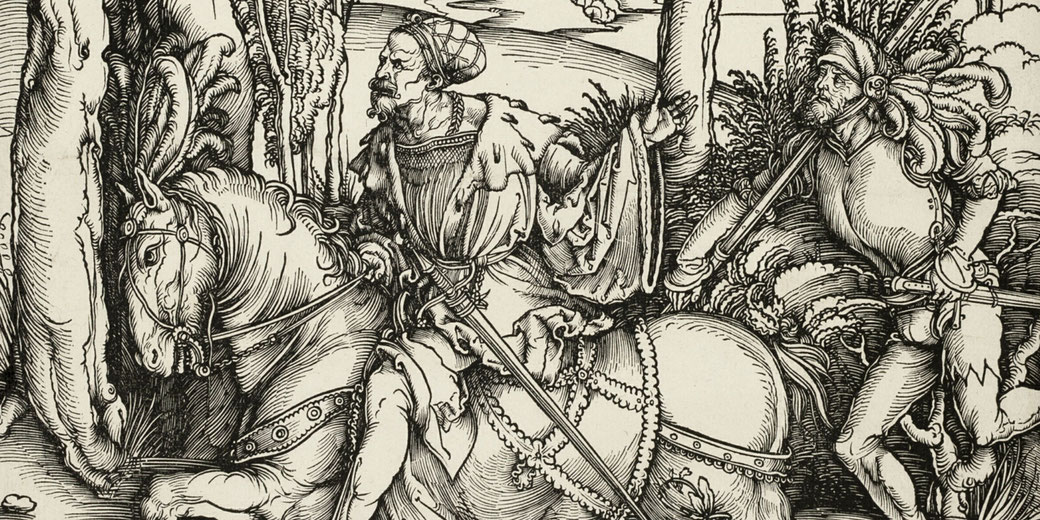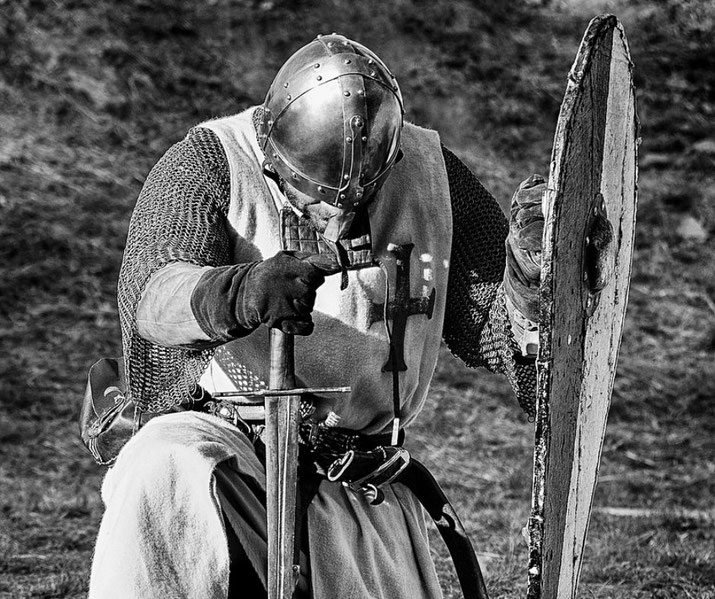The Hospitallers: crusader knights that both harmed and healed

The Knights Hospitaller began as caregivers for pilgrims but evolved into one of the most powerful religious military orders of the medieval world.
Their white cross on a black habit came to symbolise both compassion and violence. From the alleys of Jerusalem to the harbours of Malta, their history revealed a blend of practical care and military strength that secured their continued existence.
Origins of the Order
The Knights Hospitaller began in the early 11th century, when Amalfitan merchants gained permission from the Fatimid Caliph of Egypt to establish a hospital in Jerusalem dedicated to St. John the Baptist.
Constructed sometime between 1070 and 1080 near the Church of the Holy Sepulchre, this facility aimed to care for sick and poor Christian pilgrims who travelled to the Holy Land during a time of growing religious traffic and increased risk.
Following the First Crusade’s capture of Jerusalem in 1099, the hospital had come under the control of Blessed Gerard, whose leadership gave it a more organised and religious character.
By 15 February 1113, Pope Paschal II had issued a papal bull that officially recognised the community as an independent religious order.
The bull confirmed that the community was free from control by local bishops and placed it directly under papal protection.
Members took vows of poverty, chastity, and obedience and committed themselves to the spiritual and physical care of pilgrims and the poor.
Role in the crusades
Over time, the Order expanded its mission from its original purpose. By the mid-12th century, under the leadership of Grand Master Raymond du Puy, the Hospitallers had begun to take on military responsibilities in addition to their charitable role, which had already grown due to the steady flow of pilgrims and the steady threat of violence along the routes to the Holy Land.
Du Puy made these changes official in the Rule of Raymond, which adapted monastic rules to include knightly duties.
The Order constructed defensive centres such as Bethgibelin and Margat and later occupied the large fortress of Krak des Chevaliers, which became one of the strongest defensive structures in the region.
The Hospitallers took part in key battles, including the Battle of Montgisard in 1177 and the siege and capture of Ascalon in 1153.
They also suffered defeat at Hattin in 1187. Financial support from European nobles, who donated land, money, and relics, helped the Order sustain both its military and medical activities across the Latin East.

Relations with other Orders
The rise of other religious-military orders, particularly the Knights Templar and the Teutonic Knights, created an environment of both cooperation and competition.
Though they often fought alongside one another against Muslim forces during the major Crusades, each order operated independently, with its own leadership, resources, and territorial aims, which frequently brought them into conflict over fortresses, funding, and church privileges.
One notable example of this rivalry occurred over the castle of Gaza, which both the Hospitallers and Templars claimed.
European monarchs and local lords, aware of the power and influence wielded by these orders, sometimes exploited these rivalries for political advantage, especially when distributing land or settling disputes over church control.
On occasion, papal intervention was necessary to mediate disputes, such as that of Pope Innocent III in 1209.
The Hospitallers kept contacts with royal courts across Europe to secure donations and recruit new members.
These contacts helped the Order to survive in competitive and unstable politics.
Crisis in the Holy Land
The fall of Jerusalem to Saladin in 1187 was a turning point for all Crusader institutions, including the Hospitallers.
Forced to relocate their main base to Acre, they continued to support pilgrim care and military defence, although their military position steadily worsened.
The loss of Jerusalem disrupted their established routes and reduced the flow of Western pilgrims, which in turn affected the size and effectiveness of their care work.
Between 1187 and 1291, the Order struggled to maintain its influence as Muslim forces reclaimed territory across the Levant.
The final blow came with the fall of Acre in May 1291, where the Order lost both its military headquarters and most of its remaining hospital infrastructure in the region.
Some survivors briefly held out on Arwad Island before they relocated to Cyprus, where they attempted to rebuild their organisation, although many questioned whether the Order could continue to exist without a territorial base in the Holy Land.
Exodus to Cyprus
In the aftermath of Acre’s fall, the Hospitallers re-established themselves on the island of Cyprus, which offered proximity to former Crusader strongholds and allowed them to maintain a fleet capable of escorting pilgrims and transporting supplies to the Holy Land.
Limassol became their temporary base, although the island’s local politics under the Lusignan dynasty often brought them into conflict with local authorities.
Limited in resources and influence, the Order used this time to regroup and plan a more permanent solution.
During the early 14th century, the leadership identified the island of Rhodes as an ideal candidate for relocation due to its easily defended position, fertile land, and access to key maritime trade routes in the eastern Mediterranean.
The Order in Rhodes
By 1306, Grand Master Foulques de Villaret had secured papal backing and had initiated a campaign to capture Rhodes, which at the time was officially under Byzantine rule but actually run by Genoese mercenaries and local rulers.
After a four-year struggle that involved long sieges and careful diplomacy, the Hospitallers successfully seized the island in 1310 and immediately began transforming it into a fortified headquarters.
The city of Rhodes saw the construction of massive walls, towers, and a naval dockyard, which allowed the Order to launch raids against Muslim shipping and to defend Christian vessels.
The fortifications used techniques from European military engineers, especially those from Italy and Burgundy.
The hospital in Rhodes, designed to hold hundreds of patients, became an example of medieval medical care, offering surgical care, herbal treatments, and quarantine areas that rivalled those of Europe’s finest cities.
Besieged by the Ottomans
Throughout the 15th century, the rise of the Ottoman Empire posed a growing threat to Christian states around the Mediterranean.
In May 1480, Sultan Mehmed II launched a large attack against Rhodes, hoping to destroy the Order and secure a strategic port for future naval campaigns.
Under Grand Master Pierre d’Aubusson, the Hospitallers resisted the siege, repelling repeated assaults with a combination of discipline, artillery, and firm defence.
D’Aubusson was wounded during the defence but remained in command.
Although the attack failed, the Ottomans returned in June 1522 under Sultan Suleiman the Magnificent with a force estimated between 50,000 and 100,000 men.
After more than six months of siege, Grand Master Philippe Villiers de L’Isle-Adam had agreed to surrender in December, which allowed the surviving knights to withdraw with their lives and equipment.
Without a stronghold, the Order had moved around Europe for several years before they found a new home.
Transition to Malta
In 1530, Emperor Charles V of the Holy Roman Empire offered the Order the islands of Malta and Gozo, along with the North African port of Tripoli, in exchange for an annual tribute of a falcon delivered on All Saints' Day.
Though smaller and less prosperous than Rhodes, Malta offered a defensible position in the central Mediterranean, and its harbours allowed the Order to rebuild its fleet and strengthen the defences of the surrounding settlements.
Tripoli was lost to the Ottomans in 1551, leaving Malta as their final stronghold.
The Great Siege of Malta in 1565 provided the Order with one of its best-known victories.
Led by Grand Master Jean de Valette, the Hospitallers withstood a massive Ottoman invasion from 18 May to 11 September, which ultimately failed due to firm resistance and the arrival of Spanish reinforcements.
The defenders, who numbered fewer than 6,000, held off an attacking force of around 30,000 to 40,000.
Following this victory, they founded the new fortified capital of Valletta in 1566, named after de Valette, which became both a defensive stronghold and a busy centre of trade and government.
Hospitallers as a naval power
From their base in Malta, the Hospitallers developed a powerful naval presence.
They used their galleys to patrol the central Mediterranean and to defend against Barbary pirates who threatened Christian shipping.
Their navy engaged in regular skirmishes with corsairs, took part in large-scale campaigns coordinated by the Holy League, and supported the campaign that culminated in the Battle of Lepanto in 1571, where the Ottoman fleet suffered a clear defeat.
The Order’s naval strength also supported its financial self-sufficiency. Prize ships captured during raids were auctioned in Valletta, and their cargoes were sold to fund the construction of new vessels, fortresses, and hospitals.
The Order operated a shipyard in Birgu and later adopted larger ships such as galleasses and galleons.
Throughout the 17th century, the Hospitallers recruited skilled sailors, artillerymen, and engineers from across Europe who helped maintain their military readiness.
They also engaged in privateering with papal permission, which sometimes drew criticism from other Christian powers.
The Order in the Modern Era
By the late 18th century, the Order’s role as a military power had declined. In 1798, Napoleon Bonaparte captured Malta during his expedition to Egypt, and he claimed the island as a strategic base for the French Republic.
Because their code forbade fighting fellow Christians, the Hospitallers offered minimal resistance and surrendered.
With the loss of Malta, the Order’s political power came to an end.
After several relocations across Europe that had included stops in Trieste and Ferrara, the Hospitallers eventually set up their headquarters in Rome again, where they focused on their humanitarian and religious mission.
The Treaty of Amiens in 1802 proposed returning Malta to the Order, but Britain violated the agreement and retained control.
The Sovereign Military Order of Malta was later recognised by the Lateran Treaty in 1929.
Today, the Order retains diplomatic relations with over 100 states and operates hospitals, clinics, and emergency relief programs across the world.
They continue the charitable work that began in Jerusalem over nine centuries ago.
Their international aid arm, Malteser International, supports disaster relief and public health initiatives on a global scale.
What do you need help with?
Download ready-to-use digital learning resources
Copyright © History Skills 2014-2025.
Contact via email
With the exception of links to external sites, some historical sources and extracts from specific publications, all content on this website is copyrighted by History Skills. This content may not be copied, republished or redistributed without written permission from the website creator. Please use the Contact page to obtain relevant permission.





